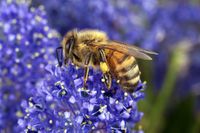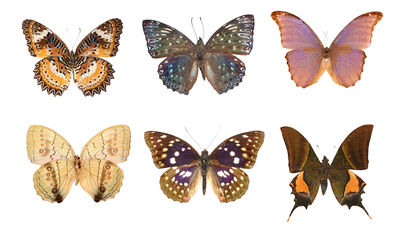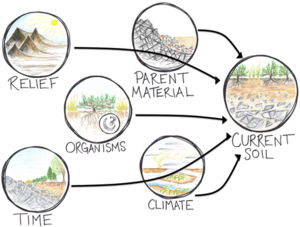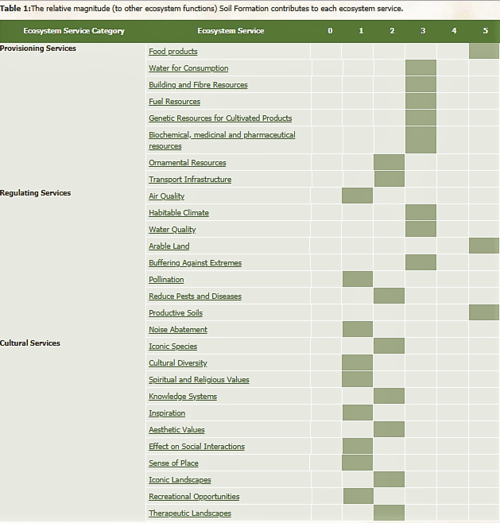Essential ecosystem services: Difference between revisions
m The LinkTitles extension automatically added links to existing pages (<a rel="nofollow" class="external free" href="https://github.com/bovender/LinkTitles">https://github.com/bovender/LinkTitles</a>). |
|||
| (58 intermediate revisions by 4 users not shown) | |||
| Line 1: | Line 1: | ||
== '''Ecosystem Services''' == | |||
[[File:Bee.jpg|200px|thumb|left|-David McClenaghan]] | |||
[[Ecosystem Services]] are the documentation of the values and the benefits derived from ecosystems and the natural resources provided by the services. Changes in [[ecosystem services]] are measured by growth and loss of economic worth for human welfare. Ecosystem services are the benefits humans gain within marine and [[terrestrial ecology]]. For example, timber, clean water, food, and various cultural values. These services can be classified into four categories: '''provisioning services''', '''regulating services''', '''supporting services''' and '''cultural services'''. | |||
| Line 10: | Line 11: | ||
== Services of Ecosystems == | == Services of Ecosystems == | ||
'''Provisioning Services:''' These services provide the ecosystem and | '''Provisioning Services:''' These services are those that provide the ecosystem and its inhabitants with energy and material. They provide essential materials and energy through the output of productivity and these can be any types of useful resources, like food or water. An example of this would be in developing countries, there is a heavy reliance on natural medicinal plants and these plant materials are provided by an ecosystem. Another example of provisioning services would be the conditions an ecosystem has that allows it's inhabitants to be able to obtain food, whether this is from growing it, collecting it, hunting it, harvesting it, or from a plants perspective, producing it. The conditions an ecosystem may have would be the amount of rainfall per "wet" or "dry" season. This would directly affect the quality of soil of the ecosystem and thus affecting the type of flora and provisioning services within the ecosystem. | ||
'''Regulating Services:''' Are the services that act as managers, maintaining the quality of air, soil, and other parts of an ecosystem. Regulating services also provide flood and disease control. An example of regulating services is Carbon Sequestration and storage. This occurs when trees and plants grow, they utilize and remove CO2 from the atmosphere. This regulates the amount of carbon dioxide in the atmosphere, provides an ecosystem with oxygen and manages change in temperature. | '''Regulating Services:''' Are the services that act as managers, maintaining the quality of air, [[soil]], and other parts of an ecosystem. Regulating services also provide flood and disease control. An example of regulating services is Carbon Sequestration and storage. This occurs when trees and plants grow, they utilize and remove CO2 from the atmosphere. This regulates the amount of carbon dioxide in the atmosphere, provides an ecosystem with oxygen and manages change in temperature. | ||
'''Supporting Services:''' Are the basis to all ecosystem services, they provide a place to live for plants and animals, while a strong diversity between plants and animals. An example of supporting services is maintenance of genetic diversity. This is how we conserve and protects unique species and maintain the diversity of species within an ecosystem. A large portion | '''Supporting Services:''' Are the basis to all ecosystem services, they provide a place to live for plants and [[animals]], while a strong [[diversity]] between plants and animals. An example of supporting services is the maintenance of genetic diversity. This is how we conserve and protects unique species and maintain the diversity of species within an ecosystem. A large portion of the maintenance of genetic diversity is documentation, because if a species is nearing what classifies as "Endangered," then action needs to be taken right away. | ||
'''Cultural Services:''' Are the non-material benefits that humans gain from an ecosystem. This can be artistic and aesthetic inspiration, cultural identity, spiritual experiences with the natural environment and even a feeling of being at home. An example of cultural services is aesthetic and artistic appreciation. Art, culture and even science has been heavily influenced by biodiversity, natural landscapes, and ecosystems. Also, language, knowledge and our natural environment have been interconnected throughout the history of humans. | '''Cultural Services:''' Are the non-material benefits that humans gain from an ecosystem. This can be an artistic and aesthetic inspiration, cultural identity, spiritual experiences with the natural environment and even a feeling of being at home. An example of cultural services is aesthetic and artistic appreciation. Art, culture and even science has been heavily influenced by biodiversity, natural landscapes, and ecosystems. Also, language, knowledge and our natural environment have been interconnected throughout the history of humans. | ||
[[File:29A57ECF-AE94-48C3-B4B0F99B027FF237.jpg|400px|thumb|left|Example of Supporting Service (documentation of genetic diversity) -Pan Xunbin]] | [[File:29A57ECF-AE94-48C3-B4B0F99B027FF237.jpg|400px|thumb|left|Example of Supporting Service (documentation of genetic diversity) -Pan Xunbin]] | ||
[[File:Aviary Photo_131606837983475382.png|400px|thumb|right|Example of "cultural service" -Nick Lohret]] | [[File:Aviary Photo_131606837983475382.png|400px|thumb|right|Example of "cultural service" -Nick Lohret]] | ||
| Line 46: | Line 47: | ||
---- | |||
== Ecosystem Service: Soil Formation == | |||
Type of Service: Supporting Service | |||
Service: Soil Formation | |||
Soil is extremely important to an ecosystems biodiversity and plays a role in the productiveness of the ecosystem. Soil plays a large role in [[Nutrient Cycling]], a benefit to humans and all living organims that is free but worth trillions of dollars per year as a major ecosystem service. Soil Formation is a supporting service because supporting services are the services that are fundamental to the productions of all other services. Soil is incredibly heterogeneous and varies from place to place. For example, it has different characteristics from country to country and even from town to town. An important factor to understanding soil formation, is understanding what parent material is. Parent material are rocks, that have been broken down, due to either physical, chemical or biological weathering. The important factor is that when there is parent material present, and along with dead [[Organic Matter|organic matter]], [[microorganisms]], plants and animals, soil can be formed. | |||
Hans Jenny, a major influence in soil [[ecology]], coined the term "[[Pedogenesis]]" or soil formation. He furthered how we view soil formation and created an equation displaying factors of soil is formed and this equation is called the [[Jenny Equation]]: | |||
[[File:soil-forming-factors.png|300px|left|thumb|-Ruth Heindel]] | |||
'''S=f(cl,o,r,p,t,...)''' | '''S=f(cl,o,r,p,t,...)''' | ||
Soil=Formation(Climate, Organisms, Relief or Topography, Parent Material, Time, ...) | Soil=Formation(Climate, [[Organisms]], Relief or Topography, Parent Material, Time, ...) | ||
[[File:Screenshot (60).png|500px|right|thumb|-SouthEast Queensland Ecosystem Framework.]] | |||
Soil Formation directly and indirectly affects other processes and benefits within an ecosystem. The chart below, gives the processes and benefits within each ecosystem service that is directly or directly affected by soil formation and these are specific to Southeast Queensland in Australia. The processes and benefits closest to "5" are the strongest relationship and can be described as occurring as a direct result of soil formation. Three benefits from ecosystem services fit within "5" or the strongest direct relationship, arable land or land that is ideal for growing crops, food products, and productive soil. Most benefits and processes are related and interconnected in some way. For example, if quality soil forms within an area, the productive natures of the soil will be high and in most cases, this makes for arable land or ideal conditions for growing crops. This is why for Southeast Queensland, there is a direct relationship between soil formation and the productiveness and land use of the region. Soil formation and the rate of production in the soil will always have a strong relationship because there are very similar factors that mold each other. | |||
*''Productive Soil'' contributes to the production of food, like in [[agriculture]], and the production of fuel and building materials. Productive soils are made up of minerals, water and living organisms. Productive soils take thousands of years to develop by the weathering of parent material. What makes soil productive is the biodiversity of organisms that live within the soil and the processes that occur within the soils that provide benefits for these organisms. With that being said, the factors within the Jenny equation, are crucial in forming productive soil. For example, soil formed in the tundra is significantly less productive than soil formed in rain forests due to the drastic difference in climate. Climates within rain forests are ideal for organisms and microorganisms that aid in the contribution to productive soils. An ecosystem with productive soil provides more ecosystem services. | |||
*''Arable Land'' is the highly abundant land to an ecosystem that has high quality soil capable of producing food year after year and this is due to it's high level of productivity, an important portion to enhancing this ecosystem service. For Southeast Queensland in Australia, the framework team found that the soil is among the most productive and has quality, "arable land." The area was described by the framework team as "a unique resource," due to it's high level of fertility, ideal water-storing capabilities, deep drainage and groundwater that is in good condition and is provided with an exceptional, mild climate. | |||
*''Food Products'' are essential to human life and provide humans with crucial and nutritious sources of vitamins, sugars, carbohydrates, and important undigested cellulose and fibers that support the survival of humans. Food production is dependent on or an outcome of, the many biological, chemical, and physical processes that occur within an ecosystem. Almost all ecosystem services have a strong relationship with "Food Products" or how organisms grow, gather, produce and eat food. For Southeast Queensland, the soil is extremely productive and the land is considered arable. Also, the climate is ideal, making the diversity of food products extremely high with minimal human input. | |||
== References == | == References == | ||
Andrews, William A. 1973. "[[Soil Ecology]]." Englewood Cliffs, New Jersey. Published by Prentice-Hall, Inc. | |||
Braun De Torrez, Elizabeth. Bauer, Dana. Fleming, H. Theodore. Kunz, H. Thomas. Lobova, Tatyana. 2011. March 30. "Ecosystem Services Provided by Bats." https://nyaspubs-onlinelibrary-wiley-com.gate.lib.buffalo.edu/doi/abs/10.1111/j.1749-6632.2011.06004.x | |||
Callaham Jr., Mac A. 2018. "Fundamentals of Soil Ecology." London, United Kingdom. Kidlington, Oxford. San Diego, California. Cambridge, Massachusetts. Candice Janco. | |||
Food and Agriculture Organization of the United Nations. "Provisioning Services." http://www.fao.org/ecosystem-services-biodiversity/background/provisioning-services/en/ | |||
Food and Agriculture Organization of the United Nations. "Regulating Services." http://www.fao.org/ecosystem-services-biodiversity/background/regulating-services/en/ | |||
Haines-Young, Roy. Tantram, Dominic. 2011. Jun, 14. "What are Ecosystem Services."http://www.ecosystemservices.org.uk/contact.htm | |||
Queensland Government. 2013. October 8. "How Soils Form." https://www.qld.gov.au/environment/land/soil/soil-explained/forms | Queensland Government. 2013. October 8. "How Soils Form." https://www.qld.gov.au/environment/land/soil/soil-explained/forms | ||
SEQ Ecosystems Services Project. 2005. "Ecosystems Services, Arable Land." http://www.ecosystemservicesseq.com.au/step-5-services/arable-land | |||
SEQ Ecosystems Services Project.2005. "Ecosystem Services, Food Product." http://www.ecosystemservicesseq.com.au/step-5-services/food | |||
SEQ Ecosystems Services Project. 2005. "Ecosystem Services, Productive Soils." http://www.ecosystemservicesseq.com.au/step-5-services/productive-soils | |||
http://www.ecosystemservicesseq.com.au/step- | SEQ Ecosystems Services Project.2005. "Ecosystem Functions, Soil Formation." http://www.ecosystemservicesseq.com.au/step-3-functions/soil-formation | ||
http://www. | T.E.E.B. "Ecosystem Services." http://www.teebweb.org/resources/ecosystem-services/ | ||
Wallace, Ken J. 2007 October. "Classification of Ecosystem Services: Problems and Solutions." https://www.sciencedirect.com/science/article/pii/S0006320707002765 | |||
---- | ---- | ||
Picture References: | '''Picture References:''' | ||
Heindel, Ruth. 2015. January, 23. "An Apatite for Kenyte." https://dartmouthigert.wordpress.com/2015/01/23/an-apatite-for-kenyte/ | |||
McClenaghan, David. "Bee Collecting Pollen." http://www.scienceimage.csiro.au/image/3822/bee-collecting-pollen/ | McClenaghan, David. "Bee Collecting Pollen." http://www.scienceimage.csiro.au/image/3822/bee-collecting-pollen/ | ||
Pan Xubin. "Diversity and Classification." http://www.bioedonline.org/slides/content-slides/diversity-and-classification/ | |||
Southeast Queensland Ecosystem Framework. "Ecosystem Functions." http://www.ecosystemservicesseq.com.au/step-3-functions/soil-formation | |||
Latest revision as of 13:05, 10 May 2023
Ecosystem Services

Ecosystem Services are the documentation of the values and the benefits derived from ecosystems and the natural resources provided by the services. Changes in ecosystem services are measured by growth and loss of economic worth for human welfare. Ecosystem services are the benefits humans gain within marine and terrestrial ecology. For example, timber, clean water, food, and various cultural values. These services can be classified into four categories: provisioning services, regulating services, supporting services and cultural services.
Services of Ecosystems
Provisioning Services: These services are those that provide the ecosystem and its inhabitants with energy and material. They provide essential materials and energy through the output of productivity and these can be any types of useful resources, like food or water. An example of this would be in developing countries, there is a heavy reliance on natural medicinal plants and these plant materials are provided by an ecosystem. Another example of provisioning services would be the conditions an ecosystem has that allows it's inhabitants to be able to obtain food, whether this is from growing it, collecting it, hunting it, harvesting it, or from a plants perspective, producing it. The conditions an ecosystem may have would be the amount of rainfall per "wet" or "dry" season. This would directly affect the quality of soil of the ecosystem and thus affecting the type of flora and provisioning services within the ecosystem.
Regulating Services: Are the services that act as managers, maintaining the quality of air, soil, and other parts of an ecosystem. Regulating services also provide flood and disease control. An example of regulating services is Carbon Sequestration and storage. This occurs when trees and plants grow, they utilize and remove CO2 from the atmosphere. This regulates the amount of carbon dioxide in the atmosphere, provides an ecosystem with oxygen and manages change in temperature.
Supporting Services: Are the basis to all ecosystem services, they provide a place to live for plants and animals, while a strong diversity between plants and animals. An example of supporting services is the maintenance of genetic diversity. This is how we conserve and protects unique species and maintain the diversity of species within an ecosystem. A large portion of the maintenance of genetic diversity is documentation, because if a species is nearing what classifies as "Endangered," then action needs to be taken right away.
Cultural Services: Are the non-material benefits that humans gain from an ecosystem. This can be an artistic and aesthetic inspiration, cultural identity, spiritual experiences with the natural environment and even a feeling of being at home. An example of cultural services is aesthetic and artistic appreciation. Art, culture and even science has been heavily influenced by biodiversity, natural landscapes, and ecosystems. Also, language, knowledge and our natural environment have been interconnected throughout the history of humans.


Ecosystem Service: Soil Formation
Type of Service: Supporting Service
Service: Soil Formation
Soil is extremely important to an ecosystems biodiversity and plays a role in the productiveness of the ecosystem. Soil plays a large role in Nutrient Cycling, a benefit to humans and all living organims that is free but worth trillions of dollars per year as a major ecosystem service. Soil Formation is a supporting service because supporting services are the services that are fundamental to the productions of all other services. Soil is incredibly heterogeneous and varies from place to place. For example, it has different characteristics from country to country and even from town to town. An important factor to understanding soil formation, is understanding what parent material is. Parent material are rocks, that have been broken down, due to either physical, chemical or biological weathering. The important factor is that when there is parent material present, and along with dead organic matter, microorganisms, plants and animals, soil can be formed.
Hans Jenny, a major influence in soil ecology, coined the term "Pedogenesis" or soil formation. He furthered how we view soil formation and created an equation displaying factors of soil is formed and this equation is called the Jenny Equation:

S=f(cl,o,r,p,t,...) Soil=Formation(Climate, Organisms, Relief or Topography, Parent Material, Time, ...)

Soil Formation directly and indirectly affects other processes and benefits within an ecosystem. The chart below, gives the processes and benefits within each ecosystem service that is directly or directly affected by soil formation and these are specific to Southeast Queensland in Australia. The processes and benefits closest to "5" are the strongest relationship and can be described as occurring as a direct result of soil formation. Three benefits from ecosystem services fit within "5" or the strongest direct relationship, arable land or land that is ideal for growing crops, food products, and productive soil. Most benefits and processes are related and interconnected in some way. For example, if quality soil forms within an area, the productive natures of the soil will be high and in most cases, this makes for arable land or ideal conditions for growing crops. This is why for Southeast Queensland, there is a direct relationship between soil formation and the productiveness and land use of the region. Soil formation and the rate of production in the soil will always have a strong relationship because there are very similar factors that mold each other.
- Productive Soil contributes to the production of food, like in agriculture, and the production of fuel and building materials. Productive soils are made up of minerals, water and living organisms. Productive soils take thousands of years to develop by the weathering of parent material. What makes soil productive is the biodiversity of organisms that live within the soil and the processes that occur within the soils that provide benefits for these organisms. With that being said, the factors within the Jenny equation, are crucial in forming productive soil. For example, soil formed in the tundra is significantly less productive than soil formed in rain forests due to the drastic difference in climate. Climates within rain forests are ideal for organisms and microorganisms that aid in the contribution to productive soils. An ecosystem with productive soil provides more ecosystem services.
- Arable Land is the highly abundant land to an ecosystem that has high quality soil capable of producing food year after year and this is due to it's high level of productivity, an important portion to enhancing this ecosystem service. For Southeast Queensland in Australia, the framework team found that the soil is among the most productive and has quality, "arable land." The area was described by the framework team as "a unique resource," due to it's high level of fertility, ideal water-storing capabilities, deep drainage and groundwater that is in good condition and is provided with an exceptional, mild climate.
- Food Products are essential to human life and provide humans with crucial and nutritious sources of vitamins, sugars, carbohydrates, and important undigested cellulose and fibers that support the survival of humans. Food production is dependent on or an outcome of, the many biological, chemical, and physical processes that occur within an ecosystem. Almost all ecosystem services have a strong relationship with "Food Products" or how organisms grow, gather, produce and eat food. For Southeast Queensland, the soil is extremely productive and the land is considered arable. Also, the climate is ideal, making the diversity of food products extremely high with minimal human input.
References
Andrews, William A. 1973. "Soil Ecology." Englewood Cliffs, New Jersey. Published by Prentice-Hall, Inc.
Braun De Torrez, Elizabeth. Bauer, Dana. Fleming, H. Theodore. Kunz, H. Thomas. Lobova, Tatyana. 2011. March 30. "Ecosystem Services Provided by Bats." https://nyaspubs-onlinelibrary-wiley-com.gate.lib.buffalo.edu/doi/abs/10.1111/j.1749-6632.2011.06004.x
Callaham Jr., Mac A. 2018. "Fundamentals of Soil Ecology." London, United Kingdom. Kidlington, Oxford. San Diego, California. Cambridge, Massachusetts. Candice Janco.
Food and Agriculture Organization of the United Nations. "Provisioning Services." http://www.fao.org/ecosystem-services-biodiversity/background/provisioning-services/en/
Food and Agriculture Organization of the United Nations. "Regulating Services." http://www.fao.org/ecosystem-services-biodiversity/background/regulating-services/en/
Haines-Young, Roy. Tantram, Dominic. 2011. Jun, 14. "What are Ecosystem Services."http://www.ecosystemservices.org.uk/contact.htm
Queensland Government. 2013. October 8. "How Soils Form." https://www.qld.gov.au/environment/land/soil/soil-explained/forms
SEQ Ecosystems Services Project. 2005. "Ecosystems Services, Arable Land." http://www.ecosystemservicesseq.com.au/step-5-services/arable-land
SEQ Ecosystems Services Project.2005. "Ecosystem Services, Food Product." http://www.ecosystemservicesseq.com.au/step-5-services/food
SEQ Ecosystems Services Project. 2005. "Ecosystem Services, Productive Soils." http://www.ecosystemservicesseq.com.au/step-5-services/productive-soils
SEQ Ecosystems Services Project.2005. "Ecosystem Functions, Soil Formation." http://www.ecosystemservicesseq.com.au/step-3-functions/soil-formation
T.E.E.B. "Ecosystem Services." http://www.teebweb.org/resources/ecosystem-services/
Wallace, Ken J. 2007 October. "Classification of Ecosystem Services: Problems and Solutions." https://www.sciencedirect.com/science/article/pii/S0006320707002765
Picture References:
Heindel, Ruth. 2015. January, 23. "An Apatite for Kenyte." https://dartmouthigert.wordpress.com/2015/01/23/an-apatite-for-kenyte/
McClenaghan, David. "Bee Collecting Pollen." http://www.scienceimage.csiro.au/image/3822/bee-collecting-pollen/
Pan Xubin. "Diversity and Classification." http://www.bioedonline.org/slides/content-slides/diversity-and-classification/
Southeast Queensland Ecosystem Framework. "Ecosystem Functions." http://www.ecosystemservicesseq.com.au/step-3-functions/soil-formation